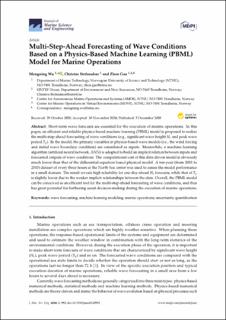| dc.contributor.author | Wu, Mengning | |
| dc.contributor.author | Stefanakos, Christos | |
| dc.contributor.author | Gao, Zhen | |
| dc.date.accessioned | 2021-01-12T15:09:11Z | |
| dc.date.available | 2021-01-12T15:09:11Z | |
| dc.date.created | 2021-01-04T13:19:12Z | |
| dc.date.issued | 2020 | |
| dc.identifier.citation | Journal of Marine Science and Engineering. 2020, 8 (12), 1-24. | en_US |
| dc.identifier.issn | 2077-1312 | |
| dc.identifier.uri | https://hdl.handle.net/11250/2722636 | |
| dc.description.abstract | Short-term wave forecasts are essential for the execution of marine operations. In this paper, an efficient and reliable physics-based machine learning (PBML) model is proposed to realize the multi-step-ahead forecasting of wave conditions (e.g., significant wave height Hs and peak wave period Tp). In the model, the primary variables in physics-based wave models (i.e., the wind forcing and initial wave boundary condition) are considered as inputs. Meanwhile, a machine learning algorithm (artificial neural network, ANN) is adopted to build an implicit relation between inputs and forecasted outputs of wave conditions. The computational cost of this data-driven model is obviously much lower than that of the differential-equation based physical model. A ten-year (from 2001 to 2010) dataset of every three hours at the North Sea center was used to assess the model performance in a small domain. The result reveals high reliability for one-day-ahead Hs forecasts, while that of Tp is slightly lower due to the weaker implicit relationships between the data. Overall, the PBML model can be conceived as an efficient tool for the multi-step-ahead forecasting of wave conditions, and thus has great potential for furthering assist decision-making during the execution of marine operations. | en_US |
| dc.language.iso | eng | en_US |
| dc.publisher | MDPI | en_US |
| dc.rights | Navngivelse 4.0 Internasjonal | * |
| dc.rights.uri | http://creativecommons.org/licenses/by/4.0/deed.no | * |
| dc.title | Multi-step-ahead forecasting of wave conditions based on a physics-based machine learning (PBML) model for marine operations | en_US |
| dc.type | Peer reviewed | en_US |
| dc.type | Journal article | en_US |
| dc.description.version | publishedVersion | en_US |
| dc.source.pagenumber | 1-24 | en_US |
| dc.source.volume | 8 | en_US |
| dc.source.journal | Journal of Marine Science and Engineering | en_US |
| dc.source.issue | 12 | en_US |
| dc.identifier.doi | 10.3390/jmse8120992 | |
| dc.identifier.cristin | 1864813 | |
| dc.relation.project | Norges forskningsråd: 223254 | en_US |
| dc.relation.project | Norges forskningsråd: 237929 | en_US |
| dc.description.localcode | © 2020 by the authors. Licensee MDPI, Basel, Switzerland. This article is an open access article distributed under the terms and conditions of the Creative Commons Attribution (CC BY) license (http://creativecommons.org/licenses/by/4.0/) | en_US |
| cristin.ispublished | true | |
| cristin.fulltext | original | |
| cristin.qualitycode | 1 | |

